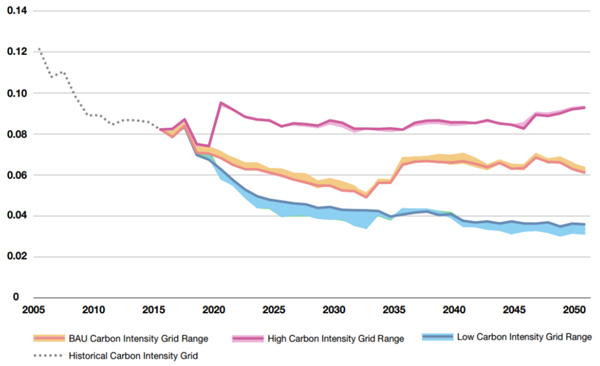By Michael Kuser
RENSSELAER, N.Y. — New York’s Integrating Public Policy Task Force (IPPTF) hit resistance on the first paragraph when it unveiled its final work plan for pricing carbon into the state’s wholesale electricity on Monday.
That section sets out the plan’s intended purpose: to explore incorporating the costs of carbon into the market while “providing the greatest benefits at the least cost to consumers.”
Several stakeholders at the Feb. 5 meeting sought a clearer definition of “benefits,” while others wanted to know why the plan would focus primarily on benefits to consumers. In addition, some expressed concerns about how carbon pricing would translate into actual carbon reductions, given existing constraints within the state.
The IPPTF is a joint effort of NYISO and the state’s Department of Public Service (17-01821). The group’s latest plan includes five issue tracks, reduced from six: 1) straw proposal development; 2) wholesale energy market mechanics (including “carbon leakage” and how to measure emissions) and interaction with other wholesale market processes; 3) policy mechanics, such as setting the carbon charge; 4) interaction with other state policies; and 5) customer impacts. (See New York Stakeholders Debate Carbon Policy ‘Issue Tracks’.)
Energy Market Primer
IPPTF co-chair Marco Padula, DPS deputy director for market structure, clarified that the group wasn’t created to review the contents of the state’s Clean Energy Standard but to achieve the objectives set out in the rule — namely, that 50% of New York’s electricity come from renewable energy sources by 2030.
Padula said the task force should work out the details of each track over the course of the year, as it posts reports from each meeting along with stakeholder comments. The task force will meet nearly every Monday to work through the tracks and plans to develop preliminary proposals by early August to deliver a unified proposal by December.
Erin Hogan, of the DPS Utility Intervention Unit, said the task force needs to better understand what goal is being discussed because state policy calls for 50% of the target to be met by energy efficiency measures, meaning “that renewables needed afterwards would be less.”
In the near future, stakeholders “should perhaps have a primer, maybe a little presentation just to level what exactly we’re talking about, so we don’t tie ourselves up in knots in the middle of meetings without having that level of understanding what the goals really are,” Hogan said.
Representing a coalition of large industrial, commercial and institutional energy customers, Couch White attorney Michael Mager reminded the task force of a key goal of the exercise.
“I don’t care whether you get to it now or when we get to the last track,” Mager said. “At the last meeting … there was some agreement in the room that, in addition to price impacts, we should also be measuring exactly what carbon abatement would be taking place. It doesn’t seem to have been reflected in the work plan, [which] still kind of limits the last track to customer impacts. It doesn’t seem to address anywhere actually measuring whether we’d be reducing carbon emissions at all.”
The Transmission-Emissions Nexus
The predicament of New York’s biggest metro area loomed large during the meeting. Ron Minsk, a consultant to New York City, delivered a presentation that emphasized the need for a new transmission to deliver renewable energy to the state’s largest load center. With a peak load of more than 11,500 MW, the city accounts for approximately 30% of the state’s load. The downstate region, including Long Island, represents about 50%. Minsk’s presentation echoed comments the city filed with the task force in January.
“We don’t want to end up having an approach where we have renewables displacing other renewables,” Minsk said. “So this gets to the transmission issues, which the city has expressed concern about before. It goes to that submission, making sure that the benefits are widely distributed. … Even with new transmission projects that are already on the books, there are transmission constraints that keep upstate power from getting downstate.”
The upstate grid is already pretty clean, with about 85% of generation carbon free, he said.
“In order to meet the state’s goals, you’re going to have to get more renewable power downstate, and, in order to do that, you have to relieve transmission,” Minsk said.
The city’s comments pointed out that NYISO has already drawn a similar conclusion, noting that even if the state adds the desired quantity of new renewables by 2030, it will not realize their full benefits without new transmission or local storage resources — or if renewable development occurs far from load centers.
Mark Younger of Hudson Energy Economics said more renewable generation will provide no consumer benefits whatsoever if it’s built in the wrong location.
“Maybe the proper way to look at it is how are you getting the cheapest dollar per ton reduction, considering that to serve New York City and the southern area, [either] you’re … paying directly for generation there or you’re paying for generation somewhere else and the infrastructure that’s necessary to get there,” Younger said.
The transmission infrastructure is part of the price of achieving the desired carbon reduction, he said.
“You can’t ignore that infrastructure because … it looks very cheap to build all your renewable resources far away, but then incur billions of dollars that you don’t recognize as part of that decision to build the resources far away,” Younger said.
The task force next meets Feb. 12 at NYISO headquarters.





